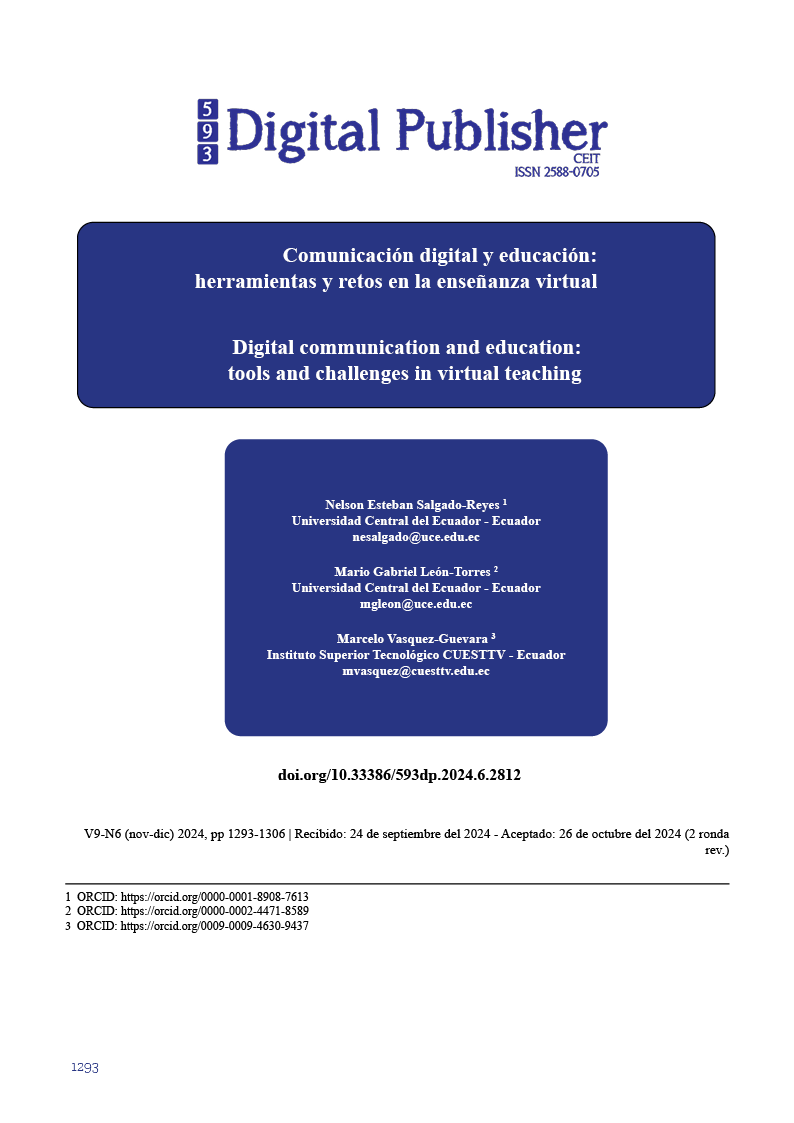Digital communication and education: tools and challenges in virtual teaching
Main Article Content
Abstract
The study investigates the influence of digital communication tools on virtual education, with a focus on their effectiveness, teacher-student interaction, accessibility barriers, and optimization strategies. Quantitative and qualitative methods were used, including regression analysis, principal components analysis and in-depth interviews. The quantitative results reveal that the use of online learning platforms and students' digital competence have a positive and significant impact on academic performance. However, student satisfaction and motivation also play a crucial role in their performance. The qualitative analyzes highlight that the limited interaction in the virtual environment negatively affects both students and teachers, reducing motivation and understanding of the material. Furthermore, inequalities in access to devices and the internet create a digital divide that makes equality in education difficult.
To address these challenges, several strategies are proposed. Among them, the development of technological training programs for students and teachers, the implementation of tools that improve online interaction, and measures to close the digital divide by providing devices and ensuring reliable internet connections. Although digital communication tools are essential for virtual education, their effectiveness depends on several factors, including digital competence, teacher-student interaction, and accessibility. Implementing strategies that address these aspects comprehensively is crucial to creating a more effective, equitable, and motivating learning environment for all students and teachers.
Downloads
Article Details

This work is licensed under a Creative Commons Attribution-NonCommercial-ShareAlike 4.0 International License.
1. Derechos de autor
Las obras que se publican en 593 Digital Publisher CEIT están sujetas a los siguientes términos:
1.1. 593 Digital Publisher CEIT, conserva los derechos patrimoniales (copyright) de las obras publicadas, favorece y permite la reutilización de las mismas bajo la licencia Licencia Creative Commons 4.0 de Reconocimiento-NoComercial-CompartirIgual 4.0, por lo cual se pueden copiar, usar, difundir, transmitir y exponer públicamente, siempre que:
1.1.a. Se cite la autoría y fuente original de su publicación (revista, editorial, URL).
1.1.b. No se usen para fines comerciales u onerosos.
1.1.c. Se mencione la existencia y especificaciones de esta licencia de uso.
References
Alenezi, M., Wardat, S., & Akour, M. (2023). The Need of Integrating Digital Education in Higher Education: Challenges and Opportunities. Sustainability, 15(6), 1-12. https://doi.org/https://doi.org/10.3390/su15064782
Anderson, T., Rourke, L., Garrison, D. R., & Archer, W. (2019). Assessing teaching presence in a computer conferencing context. Online Learning, 23(3), 25-34. https://doi.org/https://doi.org/10.24059/olj.v23i3.1538
Brown, M., & Green, T. (2019). The essentials of instructional design: Connecting fundamental principles with process and practice (4th ed.). . Routledge.
Cramarenco, R. E., Burcă-Voicu, M. I., & Dabija, D.-C. (2023). Student Perceptions of Online Education and Digital Technologies during the COVID-19 Pandemic: A Systematic Review. Electronics, 12(2), 1-19. https://doi.org/https://doi.org/10.3390/electronics12020319
Johnson, L., Adams Becker, S., Estrada, V., & Freeman, A. (2021). Horizon Report: 2021 Higher Education Edition. EDUCAUSE.
Josué, A., Bedoya-Flores, M. C., Mosquera-Quiñonez, E. F., Mesías-Simisterra, Á. E., & Bautista-Sánchez, J. V. (2023). Educational Platforms: Digital Tools for the teaching-learning process in Education. Ibero-American Journal of Education & Society Research, 3(1), 259–263. https://doi.org/https://doi.org/10.56183/iberoeds.v3i1.626
Lee, K., Choi, H., & Kim, S. (2020). Online collaborative learning in higher education: Effects on student achievement and satisfaction. Internet and Higher Education, 46, 100728. https://doi.org/https://doi.org/10.1016/j.iheduc.2020.100728
Martyushev, N., Shutaleva, A., Malushko, E., Nikonova, Z., & Savchenko, A. ( 2021). Online Communication Tools in Teaching Foreign Languages for Education Sustainability. Sustainability, 13(19), 1-17. https://doi.org/https://doi.org/10.3390/su131911127
Ng, D. T., Leung, J. K., Su, J., Ng, R. C., & Chu, S. K. (2023). Teachers’ AI digital competencies and twenty-first century skills in the post-pandemic world. Educational technology research and development, 71, 137–161. https://doi.org/https://doi.org/10.1007/s11423-023-10203-6
Robinson, J., Dusenberry, L., Hutter, L., Lawrence, H., Frazee, A., & Burnett, R. E. (2019). State of the Field: Teaching with Digital Tools in the Writing and Communication Classroom. Computers and Composition, 54. https://doi.org/https://doi.org/10.1016/j.compcom.2019.102511
Smith, K., & Jones, A. (2020). Digital transformation in higher education: The impact of COVID-19 on teaching and learning. Journal of Educational Technology Systems, 49(2), 187-204.
Tang, K.-Y., Chang, C.-Y., & Hwang, G.-J. (2021). Trends in artificial intelligence-supported e-learning: a systematic review and co-citation network analysis (1998–2019). Interactive Learning Environments, 31(4), 2134–2152. https://doi.org/https://doi.org/10.1080/10494820.2021.1875001
Tisdell, C. C. (2017). Pedagogical alternatives for triple integrals: moving towards more inclusive and personalized learning. International Journal of Mathematical Education in Science and Technology, 49(5), 792-801. https://doi.org/https://doi.org/10.1080/0020739X.2017.1408150
UNESCO. (2021). Global Education Monitoring Report 2021/2. UNESCO. https://en.unesco.org/gem-report
Wang, Q., & Liu, S. (2020). The effect of digital divide on educational inequality: A perspective of rural areas in China. Journal of Rural Studies, 75, 10-19. https://doi.org/https://doi.org/10.1016/j.jrurstud.2020.01.001




